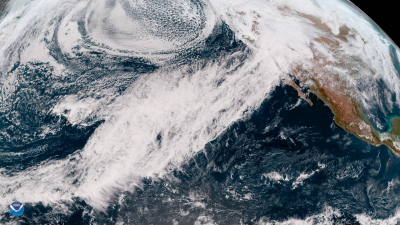Determining Where Atmospheric Rivers Get Their Moisture
The frequency of atmospheric rivers (ARs), narrow regions of very moist air flux, in the North Pacific affects the water supply and flood risk of western North America. Understanding the factors that affect where and when ARs make landfall is therefore of scientific and societal importance. A study using a novel analysis identified the sources of moisture for North Pacific ARs and how different modes of variability modulate these sources, influencing the frequency of North Pacific ARs that landfall on the west coast of North America. The frequency of atmospheric rivers (ARs), narrow regions of very moist air flux, in the North Pacific affects the water supply and flood risk of western North America. Understanding the factors that affect where and when ARs make landfall is therefore of scientific and societal importance. A study using a novel analysis identified the sources of moisture for North Pacific ARs and how different modes of variability modulate these sources, influencing the frequency of North Pacific ARs that landfall on the west coast of North America.
Researchers used the analysis presented in this study to develop an index for monitoring ARs. Referred to as the “AR background index,” the index relates the phases of intra-seasonal, seasonal, and inter-annual variability of the background moisture flux to the likelihood of AR landfall over the U.S. West Coast every month. The index has potential applications for sub-seasonal-to-seasonal landfalling AR prediction. These predictions are important for water resource management and flood-related emergency preparedness.
Defined by elongated and anomalous high-water vapor transport, moisture sources, and their variability influence AR frequency. This study shows that in the winter, the background moisture flux in ARs is related to the outflow from the subtropical high and is directed northward. In the summer, as part of the Asian monsoon, background moisture flux is northwestward. This seasonal variation in the background moisture flux leads to a seasonal northwest/southeast movement of the AR frequency pattern. At the intra-seasonal scale, the eastward propagation of the Madden-Julian Oscillation introduces an anti-clockwise rotation in the background moisture flux direction over the Pacific Ocean. The moisture is then transported northward in phases 1 and 2, westward in phases 3 and 4, southward in phases 5 and 6, and eastward in phases 7 and 8. Therefore, landfall over the west coast of North America is most likely during the last two phases. El Niño Southern Oscillation variability also affects the frequency of ARs in a similar manner. It favors landfall over the U.S. West Coast during strong El Niño phases when the moisture flux is directed eastward from the Pacific Ocean toward North America.

